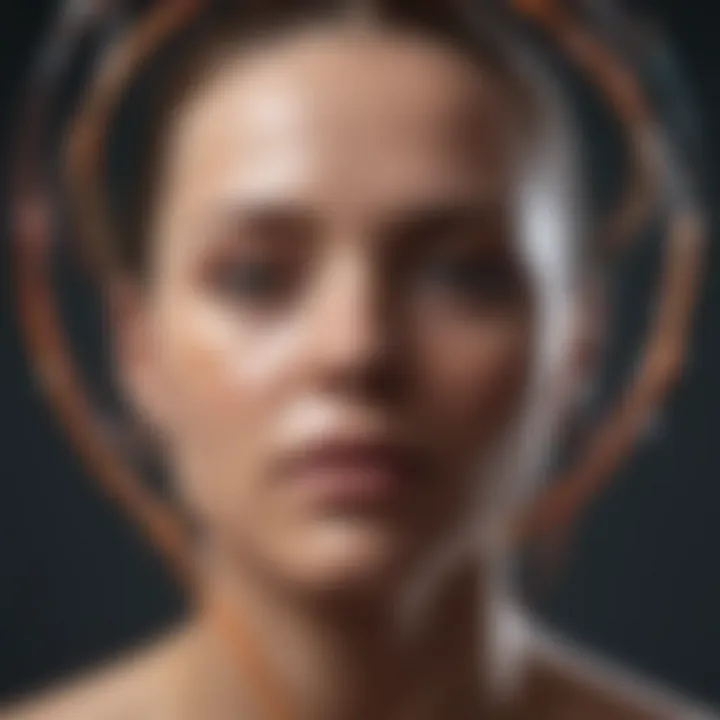Exploring Body Awareness in Psychology and Rehabilitation


Intro
Body awareness refers to the conscious recognition and understanding of one’s physical self in relation to the environment. It is not merely about being in tune with one's body but also involves a deeper comprehension of how this awareness can influence psychological well-being. As we navigate through life, the awareness of our bodies intertwines with our mental state, affecting not just how we perceive ourselves, but also how we interact with the world around us.
At the core, developing body awareness presents itself as a vital journey that weaves through various stages of life. From the initial stages in childhood, where our movements start to define our identities, to adolescence and adulthood, body awareness evolves alongside us. This article will dissect the concept meticulously, reflecting its impact across different fields such as psychology, physical education, and rehabilitation.
In exploration of the significance of body awareness, we will delve into:
- The foundational principles of body awareness and why it matters.
- Key findings that illustrate its role in mental health.
- Strategies and methodologies to enhance this awareness.
- The implications for personal development and overall health.
Recognizing body awareness is not only about fostering a conscious connection with our physical form but also about understanding its broader implications. Let's set forth into this nuanced landscape, unraveling the many layers that contribute to our holistic understanding of ourselves.
Foreword to Body Awareness
The significance of body awareness extends beyond mere physical perception; it serves as a bridge connecting our inner selves to the external world. This concept incorporates an understanding of how our body acts, feels, and moves, allowing for a more profound awareness of our physical being in relation to our emotions and the environment. By cultivating this awareness, individuals can experience a multitude of benefits ranging from improved mental clarity to enhanced physical performance. The journey toward better body awareness can lead to a more fulfilling life, enabling one to engage fully with both their mental and physical dimensions.
Awareness of one’s body can also be seen as a compass for emotional navigation. As we go through our daily lives, subtle changes in physical state can signal underlying emotions. Recognizing these cues allows for greater emotional regulation, potentially mitigating issues of anxiety or distress that may otherwise take center stage.
In this article, we will delve deeper into this intriguing theme, breaking it down into essential segments that clarify concepts and underline the importance of body awareness in various contexts, such as education, healthcare, and daily living. It’s not just about knowing how to stretch properly or having great posture; it’s about fostering a deep-rooted connection between mind and body.
Defining Body Awareness
Body awareness concerns the ability to perceive and understand one’s own physical state. It encompasses both proprioceptive and interoceptive awareness, meaning how we feel our body movements and positions, as well as the internal sensations we experience—like hunger, pain, or muscle tension. This capability allows individuals to respond appropriately to their physical needs and emotional states.
In practical terms, someone with developed body awareness can identify subtle signals from their body, such as when they’re overexerting themselves or when they need to pause and recharge. Consider a dancer who, through years of training, instinctively knows how to adjust their posture mid-performance to avoid injury; this is a prime example of body awareness in action.
Historical Context
The roots of body awareness go deep into history, with cultures worldwide recognizing the interplay between body and mind. Ancient practices, such as Tai Chi in China and Yoga in India, have long emphasized the connection between mental states and bodily movements. These practices help individuals cultivate mindfulness and an acute sense of their physical presence in space and time.
Philosophically, thinkers like Merleau-Ponty have pointed out that body and mind cannot exist separately; one influences the other constantly. This perspective has paved the way for modern psychological and therapeutic frameworks that emphasize body-mind integration. Body awareness is not merely an abstract notion; it's a practical cornerstone of various therapeutic techniques used today, establishing that awareness of the body involves more than just academic understanding—it is a lived experience.
"Body awareness is not just about feeling good; it is about understanding and connecting with oneself wholly."
With the pressing need for holistic approaches to health and wellness in today’s fast-paced world, the exploration of body awareness is vital for anyone seeking to enhance their quality of life. As we progress further into this article, we will examine the various facets of body awareness, its development over the lifespan, and methodologies that promise to enhance this awareness effectively.
Theoretical Frameworks
Understanding body awareness requires a careful look into the theoretical frameworks that underpin this multifaceted concept. These frameworks give context and depth to the body awareness discourse, making it easier for us to analyze its implications across various fields. The frameworks also serve as guides, helping researchers and practitioners devise methods and strategies that enhance individuals' connection with their bodies.
Delving into the theories not only allows us to grasp the various dimensions of body awareness but also highlights its importance in psychological, sociological, and educational contexts. The integration of these perspectives can lead to significant advancements in how we approach mental health, physical education, and rehabilitation.
Philosophical Perspectives
Philosophical discussions about body awareness often intertwine with theories about consciousness and self-perception. Friedrich Nietzsche's ideas, for instance, stress the importance of the body in shaping one’s sense of self. He argued that the body is not just a vessel but a critical component of our identity. This perspective lays the groundwork for understanding how our physical forms influence our thoughts, emotions, and behaviors.
In more contemporary discussions, phenomenology—particularly through the works of Maurice Merleau-Ponty—focuses on the embodied experience as an essential part of human existence. Merleau-Ponty posits that we perceive the world through our bodies; thus, body awareness becomes a lens through which we interact with our surroundings. This view encourages a profound appreciation of how sensations can inform our consciousness.
"We must never forget that the body is the bridge that leads us towards the understanding of the self."
Psychological Models
When it comes to psychological models, several frameworks provide invaluable insights into body awareness. One prominent model is the Cognitive Behavioral Therapy (CBT) approach, which highlights the relationship between thoughts, feelings, and physical sensations. Essentially, the way individuals think about their bodies can influence their emotions, which may lead to specific behaviors. This synergy between cognition and bodily awareness invites therapeutic techniques focused on reshaping negative thoughts about one’s body and improving mental health outcomes.
Additionally, the Interoceptive Awareness model emphasizes how individuals can sense internal bodily signals—like hunger or tension. This awareness can be particularly beneficial in treating conditions like anxiety and depression, where disconnection from the body often exacerbates the experience. By fostering an understanding of these internal cues, practitioners can guide individuals in developing more robust body awareness, resulting in better emotional regulation and enhanced well-being.
In summary, the theoretical frameworks encompassing body awareness are crucial in understanding its complexity. From philosophical inquiries to psychological models, this multifaceted concept reveals connections that can significantly enhance individual wellbeing across different life stages and contexts. By exploring these various angles, we create a solid foundation for fostering a deeper connection to our bodies.
Development of Body Awareness
Understanding the development of body awareness is crucial in our exploration because it highlights how our perception and relationship with our body changes through various stages of life. From the innocent curiosity of childhood to the more introspective experiences of adulthood, body awareness evolves. Recognizing these shifts helps in understanding how practical methods and strategies can be incorporated throughout different life stages. Developing body awareness is not merely about being conscious of one’s physical form. It encompasses mental, emotional, and social dimensions that contribute to an individual’s overall well-being.
Childhood and Adolescence
In childhood, body awareness is fostered through play and interaction with the environment. Children naturally engage in physical activities that refine their motor skills, balance, and coordination. For example, when a child learns to ride a bicycle, they develop a sense of spatial awareness. They begin to understand how their body moves in relation to space and obstacles. This stage is also when children start to explore their identity through physical expression—whether it's through dance or sports. Such activities not only enhance physical development but also nurture confidence and self-acceptance.
Important elements of body awareness in childhood include:
- Exploratory Movement: Children’s natural inclination to climb, run, and jump plays a significant role in shaping their awareness.
- Social Interactions: Peer influence can strongly affect body image. This can both positively encourage participation in group activities or negatively impact self-esteem through comparisons.
- Playful Learning: Engaging in games that encourage body movement, such as tag or hide and seek, helps reinforce body perception in a fun context.


As children transition to adolescence, body awareness becomes more complex. Adolescents are often more conscious of their bodies due to physical changes and social pressures. This heightened awareness can lead to both positive and negative experiences. Some young people may embrace sports and physical activities, while others may struggle with self-image issues exacerbated by societal standards.
"The body is not just a vessel; it is part of our identity, and understanding it is pivotal to our mental health."
Adulthood and Aging
As individuals move into adulthood, the role of body awareness shifts again. Adults often become more aware of the connection between their physical state and their emotional and mental health. Regular exercises like yoga or Pilates help maintain physical fitness while also promoting mindfulness. These practices support the notion of being present in one’s body, enhancing both physical health and psychological resilience.
In aging, body awareness take on another layer. Older adults may face various physical limitations, which can lead to a decline in the perception of their body. This can be distressing, influencing their self-esteem and mental health. However, engaging in gentle movement practices, such as tai chi or water aerobics, can foster a renewed sense of physicality and belonging. It encourages individuals to appreciate their bodies for their capabilities rather than their limitations.
Critical considerations for body awareness in adulthood and aging include:
- Mind-Body Connection: Practicing mindfulness helps strengthen the awareness of the body's signals and responses.
- Active Living: Engaging in structured physical activities encourages a positive relationship with one’s physical state.
- Acceptance: Learning to accept changes in the body with age can promote mental well-being and a healthy body image.
In summary, the development of body awareness throughout life stages serves as a vital component in fostering a healthy relationship with our physical selves. The experiences from childhood, adolescence, adulthood, and aging contribute significantly to our overall perception, understanding, and appreciation of our bodies.
Methodologies for Enhancing Body Awareness
Enhancing body awareness sits at the intersection of physical and mental well-being. By fostering an increased connection to one’s own body, individuals unlock numerous benefits impacting their overall quality of life. This section will introduce various methodologies, detailing the specific elements of mindfulness practices, somatic techniques, and movement therapies. Each plays a significant role in not just physical health, but extending to mental clarity and emotional stability.
Mindfulness Practices
Mindfulness practices are more than just trendy concepts; they embody ancient philosophies that emphasize present-moment awareness. When applied to body awareness, these practices encourage individuals to develop a heightened sensitivity to bodily sensations. This can mean everything from noticing the rhythm of one’s breath to detecting tension points in the muscles.
Some key mindfulness techniques include:
- Breathing exercises: Focusing on one's breath can ground an individual in the present, creating a tool for stress management.
- Body scans: This method involves mentally scanning the body for sensations without judgment. It can heighten awareness of areas that might need attention or relaxation.
- Meditation: Engaging in meditation cultivates a sense of calm and can improve the connection between mind and body.
The beauty of mindfulness practices lies in their simplicity—a few minutes a day can yield benefits that resonate throughout life. This growing body of research shows that regular practice enhances cognitive function, reduces anxiety, and fosters emotional resilience.
Somatic Techniques
Somatic techniques draw from the field of body-centered psychotherapy, focusing on the connection between mind and body. By tailoring specific movements and exercises, these techniques seek to release stored trauma and enhance bodily awareness.
Some prominent somatic techniques include:
- Feldenkrais Method: This method emphasizes learning through movement. As individuals explore simple motions, they begin to improve their coordination and self-awareness.
- Alexander Technique: This approach focuses on posture and body alignment. By being aware of how one moves, increased body awareness can lead to more fluid and less constrained movement.
- Rolfing: A physical therapy method that aims to manipulate the body's fascia to release tension and misalignments, encouraging a feeling of overall lightness.
This area of study hints at the complexities of how unresolved emotions can manifest physically. Hence, somatic techniques provide avenues for individuals to tap into their bodies, unlocking emotional and physical dimensions often overlooked in traditional practices.
Movement Therapies
Movement therapies utilize structured physical activities and exercises to deepen body awareness. These modalities aren’t limited to a single approach; they pull from diverse backgrounds, including dance, yoga, and martial arts. The fundamental goal remains to aid in establishing a coherent sense of self through dynamic physical engagement.
Notable movement therapies include:
- Dance Therapy: By using dance as an expressive medium, participants can explore their emotions and bodily communication in an artistic form.
- Yoga: More than just physical postures, yoga intertwines breath, movement, and mindfulness. Each aspect enhances the connection to one's body and promotes mental clarity.
- Tai Chi: This ancient martial art emphasizes slow, flowing movements. Practitioners often describe it as “meditation in motion,” as the focus lies on the body’s sensations during movement.
By investing in these methodologies, individuals cultivate a deeper awareness of their physical state and its relationship with their mental processes. These practices empower people, encouraging a more harmonious existence between mind and body—a gift that amplifies overall wellness.
“The body is the shadow of the mind.” - Thomas Hardy
As the exploration into body awareness continues to evolve, integrating these methodologies can serve as potential gateways for personal growth and healing. Through these techniques, a lasting awareness can transform daily experiences, leading to a more fulfilled existence.
Scientific Research on Body Awareness
Understanding body awareness is not just a luxury; it’s a necessity. Scientific research sheds light on how closely linked our physical sensations are to our mental states. Body awareness serves as a bridge that connects the mind and body, influencing how we experience emotions, navigate our environment, and engage with others. Through rigorous analyses, researchers have unearthed essential insights that unravel the interconnectedness of our neural pathways and somatic experiences.
Neurological Insights
The neurological perspective on body awareness digs deep into our brain’s architecture, revealing how bodily sensations influence cognitive processes. Studies show that certain areas of the brain light up in response to physical stimuli, notably the somatosensory cortex. This part of the brain is crucial for processing touch and proprioception, allowing individuals to understand where their bodies are in space.
For instance, participants in functional MRI studies often exhibit heightened neural activity in regions associated with self-referential processing when they practice mindfulness techniques centered on body awareness. This suggests that body-focused practices not only enhance physical perception but also improve emotional regulation. Adopting techniques like deep breathing, yoga, or even simple movements can lead to structural changes in the brain, fostering increased resilience against stress and anxiety.
Such findings emphasize that body awareness is not merely a mental exercise but a physiological one. The more we engage with our bodies, the more we bolster our mental agility and emotional well-being. This connection is integral, as understanding our body also means understanding our thoughts and feelings.
Psychosomatic Correlations
The field of psychosomatic studies investigates how our emotional and mental states can manifest in physical symptoms. A wealth of research points to the undeniable link between body awareness and mental health issues such as anxiety and depression. Disturbances in body awareness can exacerbate psychosomatic conditions, leading individuals to misinterpret genuine bodily signals.


"When individuals become disconnected from their bodies, it is often accompanied by increased levels of anxiety, stress, and even physical pain."
Consequently, enhanced body awareness can facilitate a greater understanding of emotional stimuli. Techniques like progressive muscle relaxation or body scans can aid individuals in recognizing how tension accumulates in response to emotional stressors. More importantly, this process grants the ability to release unneeded tension, offering a pathway to emotional release.
Key factors to consider include:
- The impact of body awareness on stress management.
- How increased awareness can lower instances of psychosomatic ailments.
- The role of focused breathing and body-centered therapies in nurturing resilience.
Through these lenses, psychosomatic correlations illustrate the profound impact body awareness can have—not just on physical health, but more crucially, on emotional and mental well-being. When individuals learn to reconnect with their bodies, they often experience a cascade of benefits that enhance their overall quality of life.
Body Awareness and Mental Health
The connection between body awareness and mental health is profound and deserves a closer look. Body awareness isn't just about understanding your physical form or recognizing your bodily sensations; it is intricately linked to our mental states and emotional well-being. In today’s fast-paced world, many individuals experience anxiety, stress, and disconnection from their bodies. Here, we underscore the significance of fostering body awareness as a means to improve mental health, delving into specific elements and benefits.
Impact on Anxiety and Depression
Understanding how body awareness affects anxiety and depression can prove vital for many individuals navigating these conditions. When one’s sense of body awareness diminishes, feelings of insecurity and distress can take root. People often find themselves in a cycle of disconnection. By practicing mindfulness techniques, like focused breathing or body scans, they can cultivate a better awareness of their bodies, effectively interrupting negative thought patterns.
Signs of anxiety can manifest physically, often prompting people to tighten their muscles or avoid certain movements. Recognizing these bodily cues allows individuals to intervene before the anxiety spirals out of control. Techniques like yoga or tai chi encourage blending movement with breath, grounding oneself and thereby reducing anxiety levels. Additionally, studies show that engaging in activities that promote body awareness can lead to significant decreases in depressive symptoms as well. Participants might notice that tuning into their physical forms helps to alleviate feelings of sadness or hopelessness.
“The body holds the score.” – Bessel van der Kolk
This quote resonates particularly well when discussing how depression and anxiety can clamp down on one’s sense of self. Body awareness promotes breaking down those confines and encourages one to embrace every facet of their existence.
Improving Emotional Resilience
Emotional resilience refers to the capacity to recover from stress and adversity. By honing body awareness, individuals can gain tools to navigate emotional storms more effectively. When someone develops a stronger connection with their physical sensations, it allows them to process emotions in a more profound and direct manner. For instance, when feeling overwhelmed, taking a moment to check in with one’s body can uncover emotions that might be hiding beneath the surface.
Practices such as somatic experiencing encourage individuals to move through their emotions physically, rather than bottling them up. This can take several forms, whether it's through gentle movement, dance, or even stillness. The intent is to recognize how emotions resonate within the body, rather than solely in the mind. Each individual may discover their unique response to emotional triggers, thus enhancing their ability to manage stress and setbacks.
Furthermore, by routinely cultivating body awareness, individuals can forge a richer understanding of their emotional landscapes. Essentially, this approach provides a map, allowing for more informed decisions regarding mental health strategies. Those armed with this knowledge tend to approach life’s hurdles with increased confidence and adaptability.
Body Awareness in Physical Education
Body awareness plays a pivotal role in physical education, shaping not just students’ physical skills but also their overall development. Understanding one’s body—its strengths, weaknesses, capabilities, and limitations—can significantly influence how individuals approach physical activities, sports, and even daily movements. This connection between body awareness and physical education is vital for fostering a holistic sense of health and well-being among students.
When students are encouraged to become more attuned to their bodies, they can improve their motor skills, coordination, and confidence. For educators, implementing body awareness strategies in the curriculum can lead to improved engagement in students and a more positive outlook toward physical activity.
Teaching Techniques
To effectively integrate body awareness into physical education, various teaching techniques can be adopted. Engaging students with activities that encourage movement exploration, such as dance, yoga, or even martial arts, helps them connect with their bodies on a deeper level. Here are some well-proven approaches:
- Mindful Movement: Introducing mindfulness practices that ask students to focus on their breath and body sensations can enhance their ability to tune into their physical selves. For example, exercise routines that emphasize awareness during stretching or balance activities can be very effective.
- Feedback Sessions: Providing students with constructive feedback on their movements can help them recognize patterns in their physical abilities. Video analysis can serve as a useful tool, allowing students to visually assess their form and make adjustments accordingly.
- Games and Team Activities: Utilizing cooperative games that require bodily awareness fosters social interaction along with self-awareness. Competitive sports can also be structured in a way that emphasizes personal achievement over winning, thereby promoting a healthier relationship with physical activity.
Implementing these techniques not only enhances physical competencies but also nurtures a generation that understands the importance of body awareness, aiding in injury prevention and encouraging a lifelong commitment to health.
Promoting Lifelong Engagement
Physical education should not be just a fleeting experience for students; it must set the stage for a lifelong appreciation of movement and body awareness. To ensure ongoing engagement, educators must spark curiosity and foster a positive relationship with physical activities. Some effective strategies include:
- Creating Inclusive Environments: Ensuring that all students feel welcome and included encourages participation. Activities should be adaptable to various skill levels, allowing everyone to find joy in movement, regardless of ability.
- Encouraging Self-Exploration: Allowing students the freedom to explore different forms of movement fosters a sense of ownership over their physical education journey. They can be encouraged to experiment with sports, dance styles, or fitness routines that resonate with them personally.
- Emphasizing Educational Value: Educators should highlight the connection between body awareness and everyday activities, from walking to carrying groceries. Relating physical education to real-life situations can help students understand its impact beyond the classroom.
"The journey of mastering one’s body is as enriching as any academic pursuit. It intertwines mind and body, creating a holistic understanding that benefits all areas of life."
As students learn to appreciate their bodies, they develop not only skills but also resilience, confidence, and a lasting commitment to personal health. Integrating body awareness into physical education lays the groundwork for individuals who are not only physically adept but also mentally and emotionally healthy.
The Role of Body Awareness in Rehabilitation
Body awareness occupies a pivotal position in rehabilitation practices. The relationship between one’s perception of their body and the ongoing recovery process from injury or illness cannot be overstated. Creating a profound sense of body awareness allows individuals to reconnect with their physical selves, paving the way for effective rehabilitation and healing. This section elucidates the importance of body awareness within the realm of rehabilitation, emphasizing its essential elements, benefits, and considerations.
Body awareness helps patients recognize their bodily limits and capabilities. By engaging in activities that enhance body awareness, such as guided exercises or therapeutic touches, individuals learn to tune in to their physical signals. This awareness is not merely about feeling pain or discomfort; it involves a deeper understanding of movement, posture, and overall physical health.
Physical Therapy Approaches
Physical therapy harnesses body awareness to facilitate movement rehabilitation. A key strategy involves using specific exercises that are designed to heighten the patient’s sensory perception. For instance, therapists often employ practices like proprioceptive training, which focuses on the body’s ability to sense its position in space. Through exercises like balance training or resistance activities, patients can refine their coordination and spatial awareness.
Therapists also encourage the use of mindfulness techniques during physical therapy sessions. Mindful movement invites patients to be aware of their body as they perform rehabilitation tasks. This might include focusing on how their shoulders feel during stretching, observing their breath during exertion, or noting which muscles engage during particular movements. When patients cultivate this heightened awareness, they can improve their focus on correcting movements and reducing compensatory strategies that might hinder recovery.
Occupational Therapy Applications


In the context of occupational therapy, body awareness plays a crucial role in helping individuals regain skills and autonomy in daily living activities. This form of therapy extends beyond physical capabilities and deeply involves the psychological aspect of rehabilitation. Practitioners guide clients through tasks that demand an understanding of their body’s movement and function in various environments.
For example, an occupational therapist might use everyday tasks to enhance body awareness. Simple activities like pouring a cup of water or dressing can be transformed into exercises that promote awareness of one’s movements and postures. This deliberate practice allows individuals to apply insights gained regarding their body mechanics into their daily routines.
"Cultivating body awareness in rehabilitation is not just about healing; it's about reclaiming a sense of control over one's own physicality."
Moreover, technology is increasingly being utilized in occupational therapy to enhance body awareness. Wearable devices that monitor movement and provide real-time feedback can empower clients to engage more thoughtfully with their rehabilitation process. These tools help individuals become more aware of how their body moves and reacts in different situations, bridging the gap between the therapy setting and real-life tasks.
In summary, the integration of body awareness into rehabilitation practices profoundly influences recovery outcomes. Both physical and occupational therapies leverage body awareness as a foundational component, enhancing patients’ connection to their physical selves and nurturing a conducive environment for healing and self-improvement. By cultivating this nuanced understanding of bodily sensations and capabilities, individuals can reclaim ownership of their bodies and self-confidence in performing everyday actions.
Challenges in Cultivating Body Awareness
Cultivating body awareness is not a walk in the park; it presents numerous challenges that can hinder individuals from connecting with their physical selves. Navigating these challenges is crucial for fostering a deeper understanding of how our bodies interact with our thoughts, emotions, and environment. By addressing the specific barriers that inhibit body awareness, one can adopt strategies to overcome them, enhancing the overall experience of living within one’s own skin.
Cultural Barriers
Cultural influences play a significant role in shaping how individuals perceive their bodies and engage with their physical sensations. Various cultures have distinct beliefs and practices regarding body image, movement, and awareness. For instance, in many Western societies, there is often an overwhelming focus on aesthetic standards dictated by media, which can lead to negative body image and disconnection from one’s physical form. Conversely, in some Eastern practices, the emphasis on holistic understanding fosters a more profound connection between mind and body.
- Examples of Cultural Norms:
- Western culture may promote thinness as an ideal, causing individuals to neglect their physical feelings in pursuit of appearance.
- Indigenous cultures often prioritize ritualistic practices that involve bodily awareness, thus integrating body and spirit.
These differences highlight the importance of understanding how cultural background affects body awareness. When individuals internalize cultural rhetoric, they may inadvertently strip themselves of the opportunity to cultivate a healthy relationship with their bodies. Addressing these barriers requires a thoughtful approach that respects diverse backgrounds while promoting inclusivity in body awareness practices.
Technology and Disconnection
In today’s fast-paced digital world, technology poses another challenge to body awareness. The incessant lure of screens can keep individuals distracted from their own physical sensations. Instead of tuning into our bodies, we often find ourselves glued to our devices, scrolling through social media, or engaging with virtual realities. This disconnection can lead to an unawareness of physical needs, such as hunger, fatigue, or discomfort.
- Key Points to Consider:
- Constant connectivity can foster a superficial relationship with our bodies.
- Digital distractions can lead to a lack of mindfulness, limiting our ability to be present in our physical existence.
It's vital to understand that while technology can facilitate knowledge and connection, it can also create barriers to authentic bodily experiences.
To combat this, individuals can set boundaries around technology use, adopting practices such as digital detoxes or specific hours for device-free activities. By consciously prioritizing time to reconnect with our bodies, such as engaging in movement or mindfulness practices without digital distractions, we can bridge the gap created by the technological divide.
Facing these challenges head-on is a step toward greater body awareness. By fostering cultural understanding and navigating the technological landscape, individuals can cultivate a rich relationship with their bodies, enhancing their overall well-being.
Future Directions in Body Awareness Research
Exploring the future of body awareness research is essential, especially as we stand at the crossroads where psychology, neuroscience, and physical disciplines converge. This area not only unveils the potential to deepen personal connections with our bodies but also opens doors for a more integrated understanding of wellness that marries the physical with the mental. Research on body awareness can lay the groundwork for innovative practices in therapy, education, and overall health.
Interdisciplinary Approaches
The interplay between different disciplines fosters a richer comprehension of body awareness. For instance, integrating insights from psychology can help decode the emotions tied to bodily sensations. Meanwhile, perspectives from sports science optimize movement strategies and enhance physical education curricula. Here are a few key areas where interdisciplinary collaboration could flourish:
- Psychology & Neuroscience: Understanding how brain functions influence body perceptions and vice versa. This coalescence could lead to tailored therapies that address both mental and physical health simultaneously.
- Mindfulness & Somatics: Blending mindfulness training with somatic practices can facilitate deeper awareness of bodily sensations and emotional responses, a vital step in healing processes.
- Physical Education & Health Sciences: Bridging these fields could lead to curriculum developments geared towards fostering body awareness in school-age children, thus shaping their relationship with their bodies early on.
A pivotal component worth considering is how technology, such as virtual reality or wearable devices, can enhance the learning experience, providing real-time feedback about body postures and movements.
Innovative Therapies and Techniques
The potential for novel therapies in the realm of body awareness is immense, given the ongoing advancements in technology and self-exploration methodologies. Imagine a future where therapies involve the following:
- Virtual Reality (VR) Integration: VR could provide immersive environments that help individuals experience their bodies and movements in new ways, improving body awareness and encouraging rehabilitation.
- Biofeedback Mechanisms: This offers real-time feedback by using sensors to monitor physiological functions, like heart rate or muscle tension, enabling individuals to learn how bodily responses correlate with their emotional states.
- Community-Based Programs: Initiatives that unite communities around body awareness practices—not just in gyms, but in everyday settings, promoting collective learning and support.
Investing in these promising avenues isn’t just about scientific inquiry; it’s about harnessing the profound potential of understanding our bodies. The benefits can extend far beyond individual health, reaching communal resilience and enlightenment.
By embracing these interdisciplinary synergies and harnessing innovative technologies, future research could radically transform how body awareness is nurtured, ultimately leading to a more informed and connected society. The journey ahead invites scholars, practitioners, and individuals to collaborate on this important subject, shining a light on how understanding our bodies can profoundly impact every aspect of human life.
Ending
Body awareness is a cornerstone of our existence, merging our physical sensations with our emotional states. The conclusion of this article serves as a fundamental reminder of the diverse insights surrounding body awareness while emphasizing its applications across multiple domains. Recognizing its significance aids in enhancing overall well-being, fostering not just physical health, but also emotional resilience.
Summarizing Key Insights
The journey through the various facets of body awareness has shed light on its multifaceted nature. Here are some key points to consider:
- Interconnectedness of Mind and Body: Body awareness is intricately linked to psychological health, suggesting that our physical state can impact our mental condition considerably.
- Development Over Time: The evolution of body awareness from childhood through to aging underscores the need for ongoing engagement with our physical selves. This evolution can bring about deeper self-acceptance and emotional clarity.
- Methods for Enhancement: The efficacy of employing mindfulness practices, somatic techniques, and various movement therapies highlights that there are numerous pathways individuals can take to refine their awareness of the body.
- Barriers and Challenges: We live in an era where cultural perspectives and technological distractions can hinder the cultivation of body awareness. Acknowledging these impediments is vital for effective navigation.
Encouraging Further Exploration
The importance of diving deeper into body awareness extends beyond academic inquiry. Those engaged in educational, therapeutic, and personal development settings stand to gain significantly from further exploration of this topic. Here are a few considerations:
- Practical Applications: Educators and therapists can integrate body awareness into their practice, developing curricula and programs that support physical and emotional development in students and clients.
- Research Opportunities: Scholars might explore interdisciplinary approaches to body awareness, merging knowledge from psychology, neuroscience, and physical education for innovative findings.
- Community Dialogues: Hosting workshops, discussions, or online forums around body awareness can foster community understanding and connection.
Ultimately, the continued exploration of body awareness can lead to enriched lives, improved mental health, and a greater understanding of the human body as a dynamic entity. Embracing this journey is a step towards nurturing a more profound connection with ourselves.







